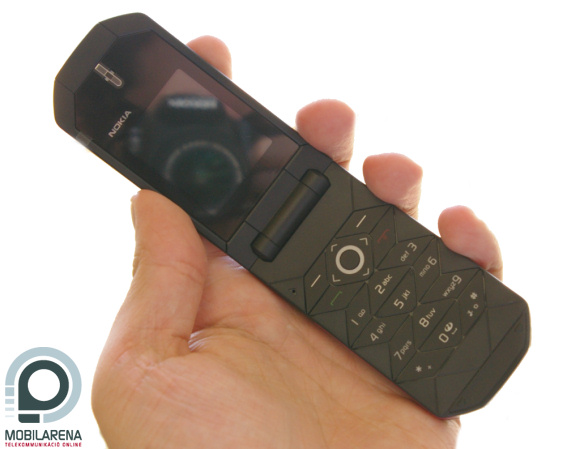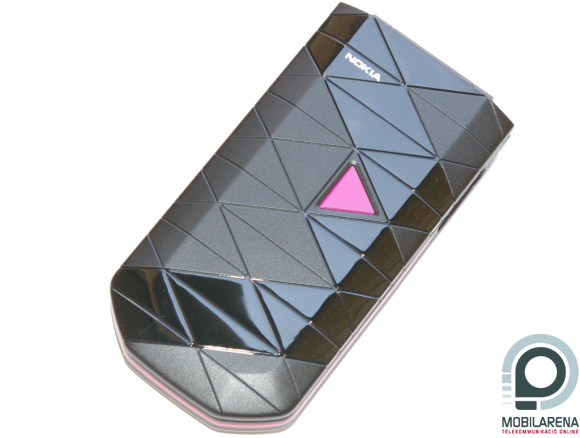Introduction, packaging
I will start this review too with some philosophical thoughts about user habits. No matter we deny it or not, nowadays the cell phones are a kind of status symbol – at least for most people – besides being a consumer good. The manufacturers know this too and this is why the category of luxury phones and fashion handsets has been created a couple of years ago, although the second one is about something different than showing off with something that costs the whole sum on our bank account. Of course not everyone wants – or dares? – to run around with a luxury phone, so many choose the top model of their favored manufacturer, independently of whether they make use of the lots of features.

The fashion phones, however, are a different category. These handsets are not cheap, so they are great to reflect (or “fake”) our financial situation, but they are mostly fashion products. A couple of years ago the phone could have been dressed up to match our clothing, but nowadays changeable front covers are gone so what is left are the shine, the shrill patterns, the uniqueness and the jewels for cell phones. We men have a bit of a hard time to understand, but a cell phone is part of the clothing for many ladies, and this is why they take their decision based on the design instead of the features when buying a phone. Still, they had some problems until now, as fashion phones were usually mid-range ones and it’s not sure that the future users wanted to make use of that. It looks like Nokia was the first to realize that this niche is still not exploited and a good-looking, but “dumb”, or basic handset should be launched, so those who would like to use a fashionable phone only for phone calls won’t have to unnecessarily buy the lots of megapixels and hi-res screen.
So here is Nokia 7070 Prism, which has been provided by XXL GSM. This is a low-end phone, so it came in a small box which only had the handset and the charger inside – not as if there would have been room for anything else.
Exterior
One of my inexperienced friends described 7070 that it’s as if “it had been brought from the Palace of Wonders”. Well, yeah, it’s really unique, but it’s by far not the first such handset, as the manufacturer had two prism handsets – even though none of them were clamshells. Sony Ericsson Z555i is a clamshell, however, and as a matter of fact this new Finnish phone resembles it quite a lot, but it’s no use discussing this. The phone is very small, we could say it fits a woman’s palm, it weighs 78 grams and its size is 87.5 x 44 x 15.8 mm. This has hindered me lots of times in performing some operations, but I’m not the targeted user, so I don’t mention this as a flaw.
The phone is available in black/blue and black/pink colors, I had the second one and I didn’t have the courage to use it on the street. The back is really spectacular; there is a small Nokia logo and lots of “prisms” (aka. triangles), part of these being shiny, while the others are matte. There is a huge pink triangle, which is not only decoration, but it’s also a status LED (or better said it’s just a status LED), in case of an incoming or missed call or new message it pulsates and as a matter of fact it looks quite cool.
It’s interesting that the back looks almost the same as the front, so if we never had the handset in our hands we will have no idea which is which. There is no pink plastic over here, but there is a speaker which got filled with dust in two days and I could get it out only with a needle – this happened in spite of not using the phone on the street. The plastics are low-quality ones, if I’d want to be cruel I’d say that they are appropriate for the assembly quality, as 7070 cracks and creaks, it has a large play when it’s closed, so it’s terrible.
It has no play, however, when it’s opened, as in this case the front and the back touch each other and the shiny prism pattern lines up, it looks as if the whole thing was one a single panel, it’s a really good solution. There is nothing on top, on the bottom and on the sides we can see the aforementioned colored stripe running around, while on the right we can see the connectors.
On the inside we can see exactly what we would expect after the exterior. There is the huge speaker on the top part with the TFT screen (1.8” diagonal, 128 x 160 pixels resolution) below it. By the way this reminds me of a low-quality cSTN screen. The view angle is minimal, practically it’s readable only from face-to-face, but only if we’re not standing in natural light, as sunrays make it unusable. The keypad is on the bottom and no matter it looks lame, it’s still easy to use, but really, the pressure point is okay.
Menu, basic functions
The phone is built on the Series 40 platform, but it’s a mystery which version does it use. I couldn’t say that it’s full and complete, as there are a couple of very important features missing (like active standby) and moreover the whole thing looks very lame on the tiny, low-res display, not mentioning that it’s very slow. The menu has a list view; there are nine items on the main menu, four being visible on-screen at the same time.



Practically we can see no extras, although we get a quite surprising picture in the media menu: there is only one menu item, the voice recorder, there is no camera or anything like that. To tell the truth there’s nothing to wonder at, as there is no camera on the phone and the 11MB internal memory is non-expandable, so the handset cannot be used for playing music and there is even no FM radio – it’s no multimedia monster, that’s sure. The voice recorder, by the way, can record one minute at most in .amr format. The usual programs (calendar, alarm clock, notepad, stopwatch, countdown timer) are fortunately included and as extras we have a catalog, unit- and currency converter, and there’s even a expense planner. There are three games; all are very primitive, although one of them is made by EA.



Basically I didn’t have problems during phone calls, besides the fact that the phone was a bit too small for me, so its bottom touched my chin, but since it’s a feminine model, this doesn’t really matter. The point is that I had no problems with voice quality. The phonebook can store 1000 contacts, there are lots of extra fields; I think it’s enough for the average user. The call log can display the received/missed/dialed calls separately or on the same page and there is a message counter too. And an e-mail client too, which is not very usual for such a phone. Since it’s a Nokia model probably no one will be surprised by the fact that there are profiles and the handset can ring and vibrate at the same time – mp3 ringtones are supported, but we can only acquire these from wap.



Data transfer, battery, summary
The little 7070 doesn’t perform very well in data transfer, the GSM-module is only a dual-band one (900/1800 MHz), it’s been a long time since I’ve seen such a thing. We can use class 10 GPRS and class 6 EDGE for data transfer and we can even browse the web as there is an xHTML browser installed, although I don’t understand why, as on such a small display not only a full webpage, but not even a longer word will fit. There’s no Bluetooth.
The battery’s capacity is 700 mAh, its type is BL-4B. As I had the phone with me for a very short time, I can’t say anything exact about the uptime, but I think it can take it for 3-4 days with one charge, but if we don’t use it too much it might take it even longer.

Summary: cheap prism. I think I have told everything about this handset with these two words. It’s unlocked edition costs a bit over €85 EUR, so currently Nokia 7070 is the cheapest fashion phone. In turn it’s slow, it’s dumb, it’s made of low quality materials, but at least it looks good from a distance. Tally-ho!
Bocha
Translated by Szaszati
Nokia 7070 Prism has been provided by XXL GSM.
The handset can be purchased at:
Budapest VI. Jókai tér 6.
Budapest VI. Teréz körút 18.
On-line at www.xxlgsm.hu.
Specifications
| Nokia 7070 Prism | ||
 | General | |
| Technology | GSM | |
| Size | 87.5 x 44 x 15.8 mm | |
| Weight | 78 grams | |
| Available colors | black/blue, black/pink | |
| Display | ||
| Display diagonal | 1.8” | |
| Display resolution | 128 x 160 pixels | |
| Display type | TFT | |
| Number of colors | 65.000 | |
| Memory | ||
| Phonebook capacity | 1000 entries | |
| SMS memory / max. MMS size | n.a. / 300 KB | |
| Internal memory | 11 MB | |
| Memory expandability | not expandable | |
| Data transfer | ||
| Frequency bands | 900/1800 MHz | |
| GPRS / EDGE | present / present | |
| UMTS / HSDPA | none / none | |
| IrDA / Bluetooth | none / none | |
| WiFi | none | |
| USB | none | |
| Push-to-talk / RSS | none / none | |
| GPS receiver | none | |
| Basic functions | ||
| Profiles | present | |
| Vibra function | present | |
| Built-in handsfree | present | |
| Voice dialing / voice commands | none / none | |
| Sound recorder | present (max. 1 minute) | |
| Alarm clock | present, also when turned off | |
| Predictive text entry | T9 | |
| Software | ||
| Platform | Series 40 | |
| WAP / HTML browser | 2.0 / xHTML | |
| E-mail client | present | |
| Java | present, MIDP 2.0 | |
| Games | 3 | |
| Currency converter | present | |
| Extra software | - | |
| Multimedia | ||
| Main camera | none | |
| Secondary camera | none | |
| Music player | none | |
| FM radio | none | |
| Battery | ||
| Main battery | 700 mAh Li-Ion | |
| Standby time | 416 hours | |
| Talk time | 300 minutes | |
| Other | ||
| - | ||

















